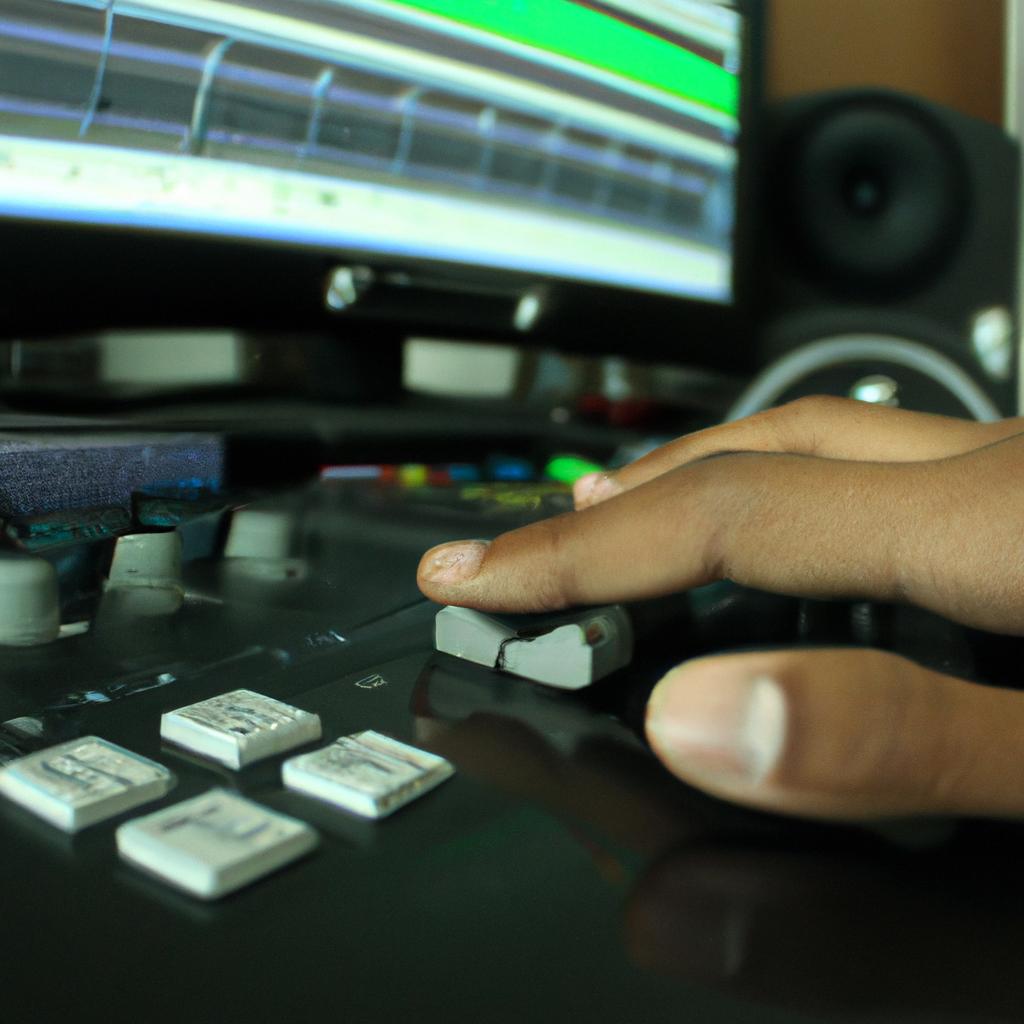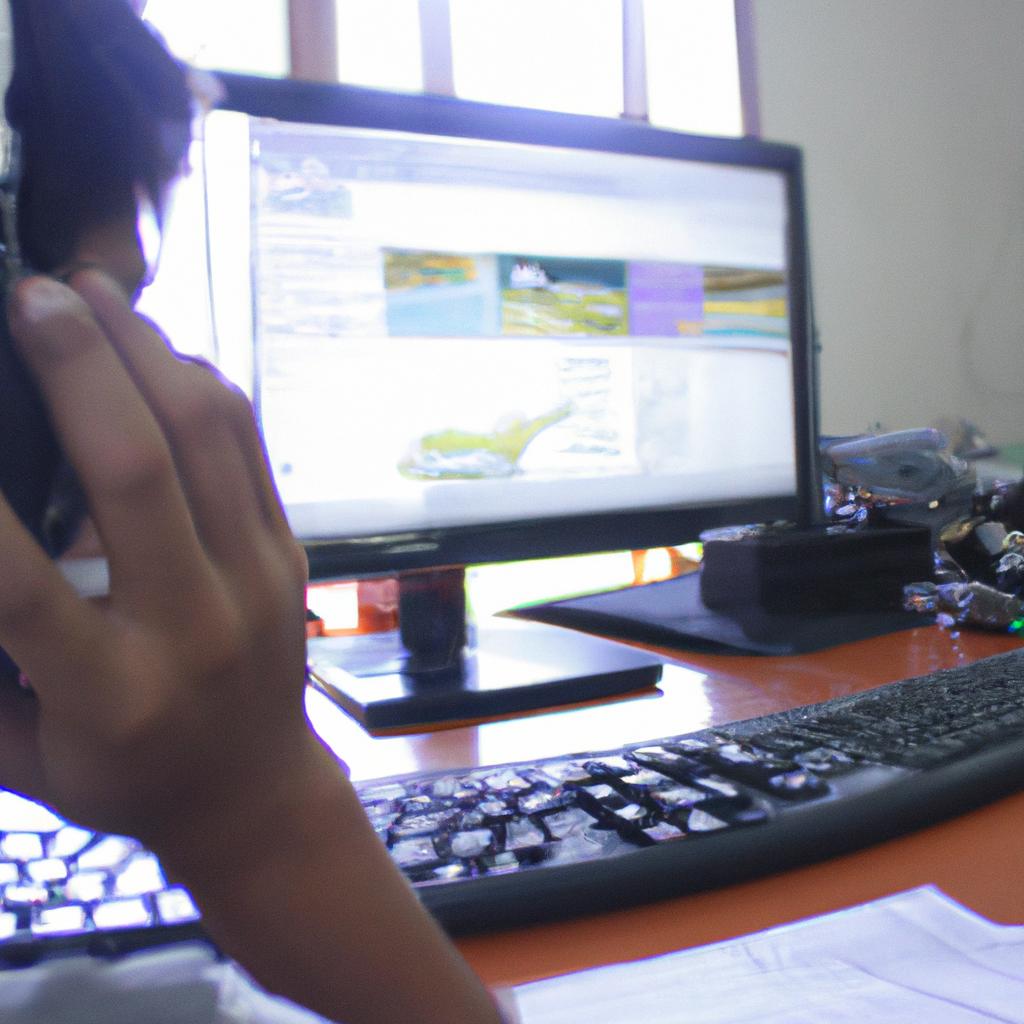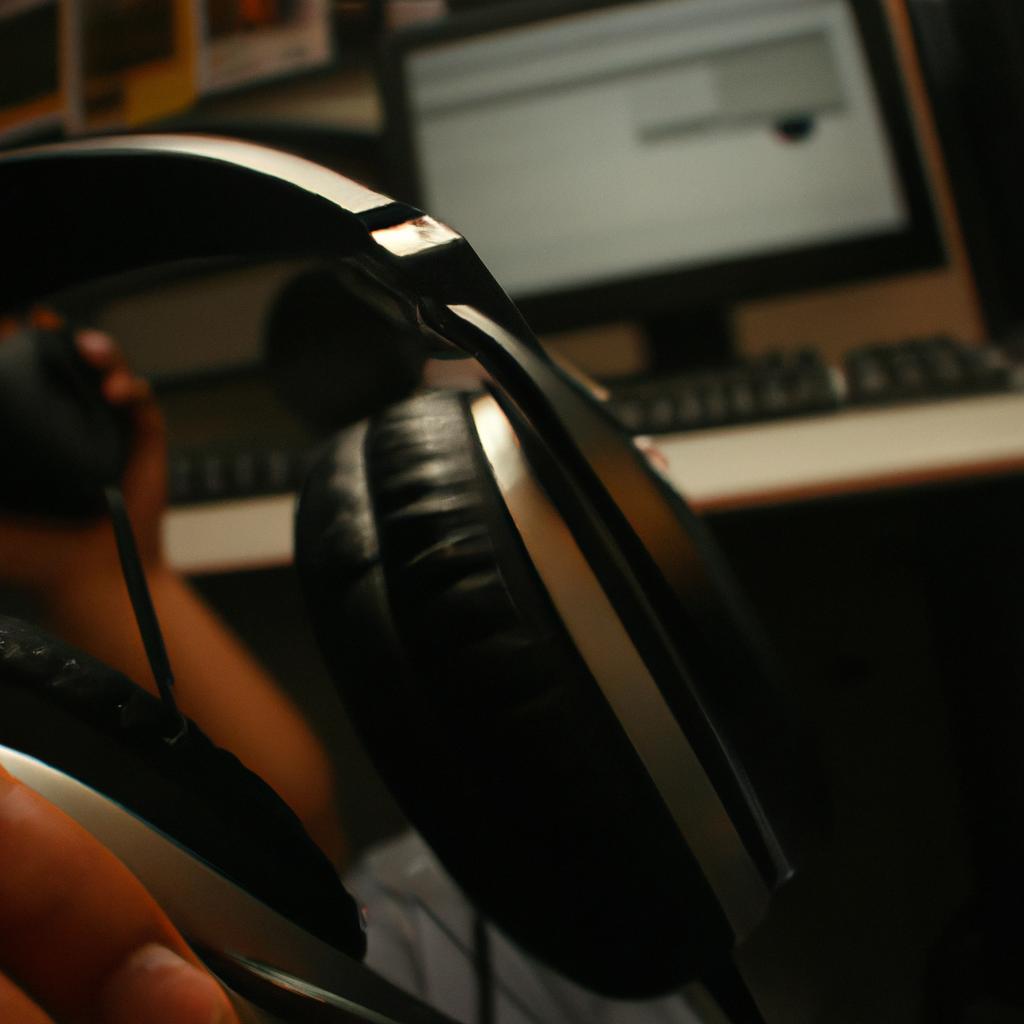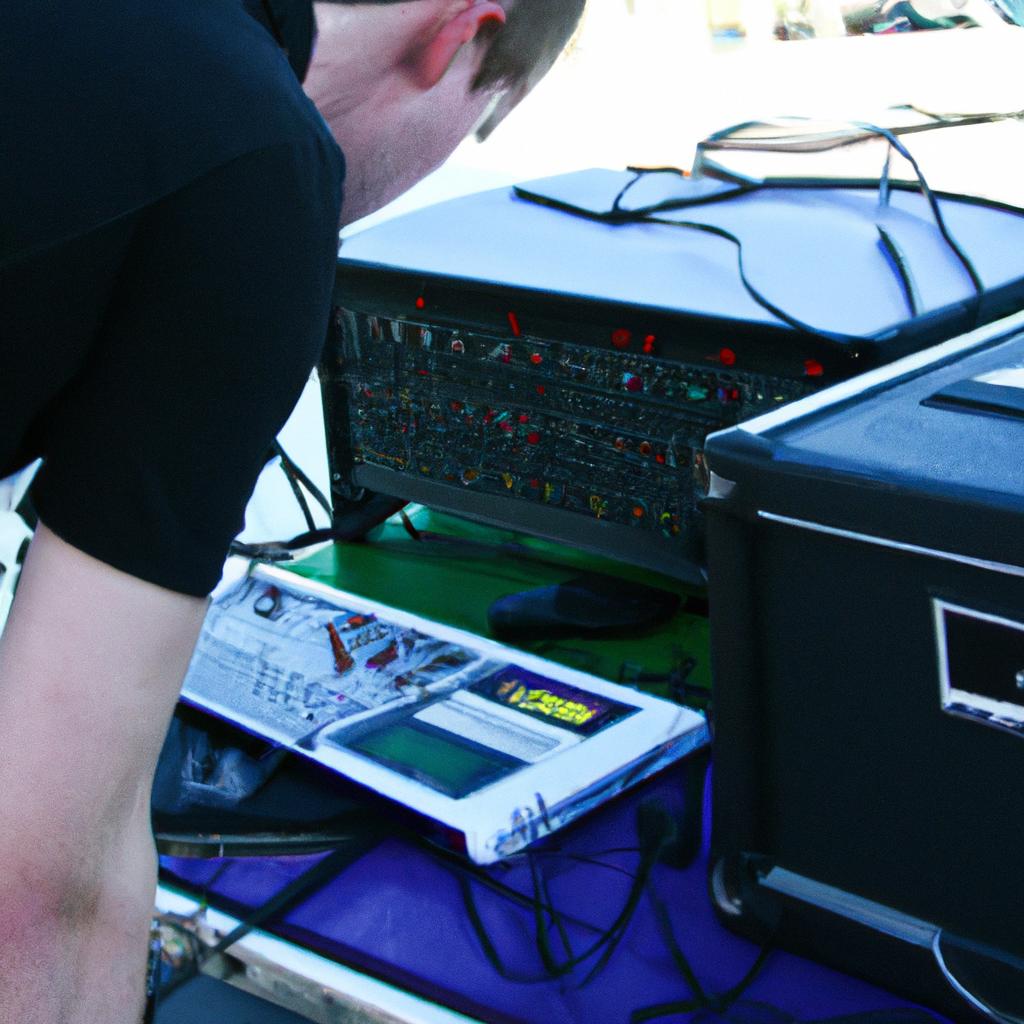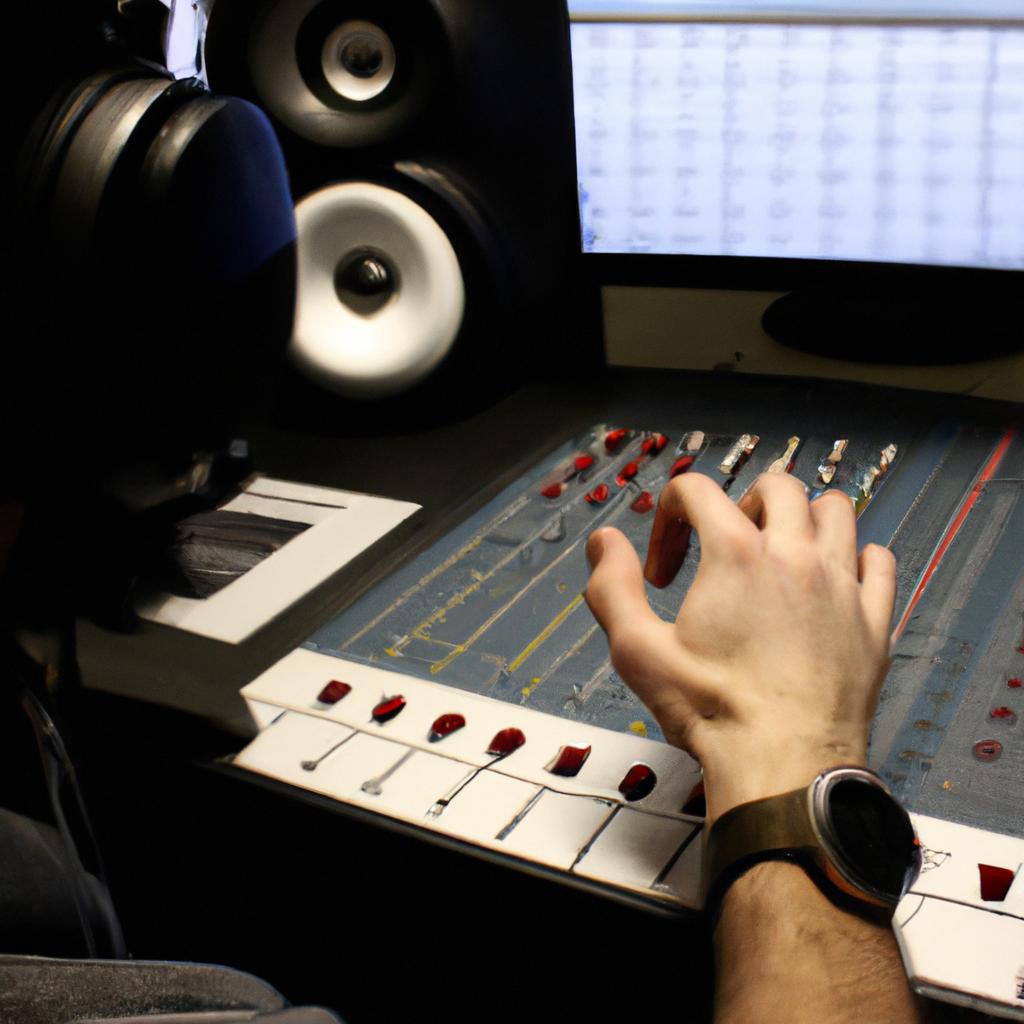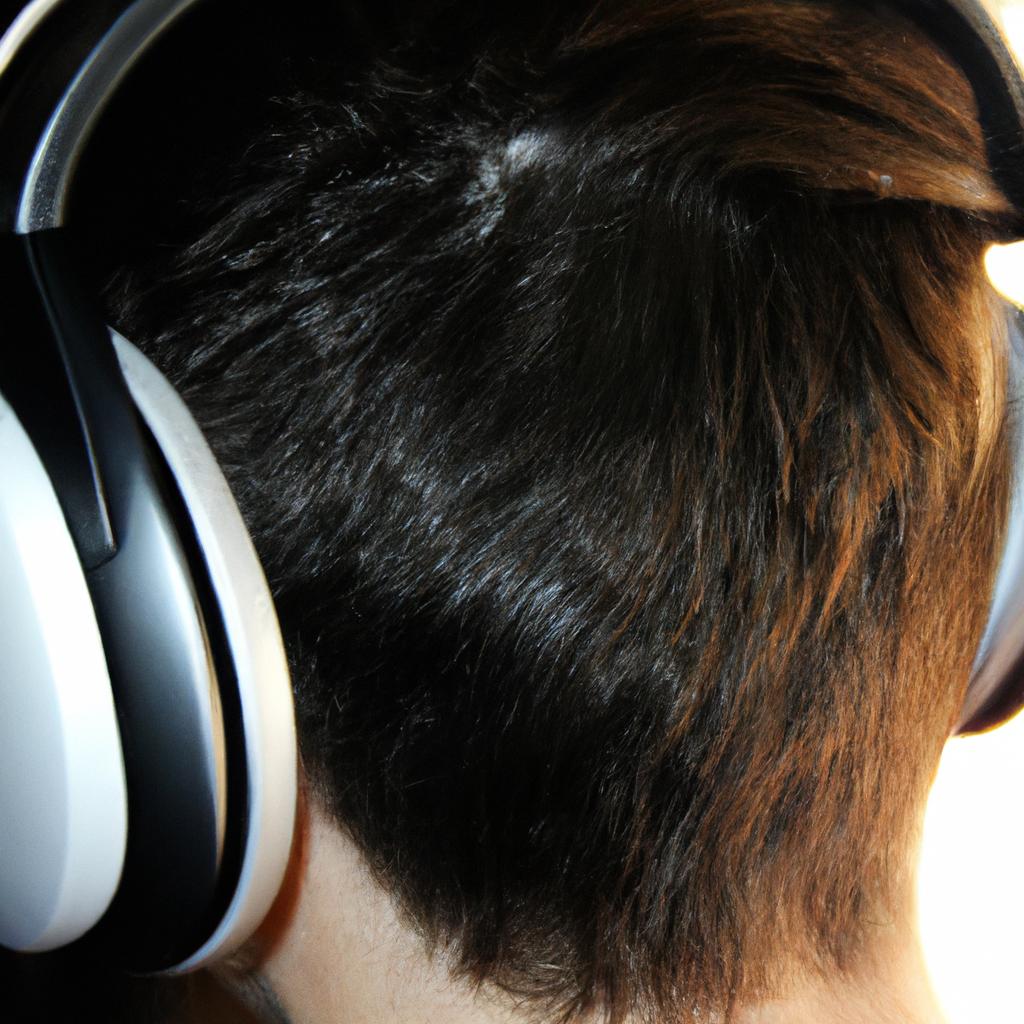Audio effects play a crucial role in enhancing the overall experience of sound and vision. Through their manipulation, audio effects can transport listeners into different realms or evoke specific emotions. For instance, imagine a suspenseful scene in a movie where the protagonist is stealthily making their way through a dimly lit corridor. The combination of eerie background music, strategically placed footsteps echoing, and subtle creaking sounds all contribute to building tension and heightening the viewer’s sense of anticipation.
In today’s digital age, advancements in technology have revolutionized the possibilities for creating and applying audio effects. In this article, we will delve into the realm of digital audio effects and explore how they are used across various industries such as film production, video game design, and music composition. By examining both theoretical concepts and practical applications, we aim to shed light on the intricate interplay between sound and vision in delivering immersive experiences to audiences. From analyzing the intricacies of surround sound systems to understanding the algorithms behind reverb plugins, our exploration aims to uncover the transformative power that lies within the digital audio dimension.
The Evolution of Audio Effects
Imagine watching a blockbuster action film and feeling the impact of every explosion reverberating through your body. Or listening to your favorite song and being transported to another world as ethereal echoes surround you. These immersive experiences are made possible by the evolution of audio effects, which have undergone significant advancements in recent years.
One example that illustrates the power of audio effects is the use of spatial sound technology in virtual reality (VR) gaming. By simulating three-dimensional audio environments, players can experience a heightened sense of realism and immersion. For instance, in a VR game set in a haunted house, audio effects can be used to create spine-chilling whispers that seem to originate from all directions around the player. This not only enhances the overall gameplay experience but also evokes emotional responses such as fear or excitement.
To further comprehend the significance of audio effects, consider these key points:
- Audio effects enable filmmakers to manipulate sounds creatively, adding depth and richness to their storytelling.
- They enhance music production by allowing artists to experiment with various sonic elements, creating unique textures and atmospheres.
- In video games, audio effects contribute to gameplay mechanics by providing auditory cues for important events or signaling changes in the environment.
- The utilization of audio effects in live performances transforms ordinary concerts into multisensory spectacles, captivating audiences on both an auditory and visual level.
| Film Industry | Music Production | Video Games | |
|---|---|---|---|
| Sound Design | Enhances narratives | Creates ambiance | Provides auditory cues |
| Mixing | Balances dialogue and SFX | Blends instruments and vocals | Integrates seamlessly with gameplay |
| Foley | Adds realism | Incorporates environmental sounds | Reinforces immersion |
| ADR | Ensures clear dialogue quality | Corrects imperfections | Syncs character voices with visuals |
In summary, audio effects have come a long way in transforming our auditory experiences. From VR gaming to film sound design and music production, these advancements have revolutionized how we perceive sound. In the subsequent section, we will explore the role of audio effects in enhancing visual experiences, further delving into their impact on various forms of media entertainment.
The Role of Audio Effects in Enhancing Visual Experiences
As technology continues to advance, audio effects have played a crucial role in shaping the way we experience sound and vision. One notable example is the use of audio effects in movies to enhance storytelling and create immersive experiences for viewers.
In recent years, filmmakers have utilized audio effects to transport audiences into different worlds by manipulating sounds. For instance, imagine watching an action-packed scene where a car chase unfolds onscreen. Through the strategic use of audio effects, such as engine revving and screeching tires, viewers can feel as though they are right there in the midst of the adrenaline-fueled pursuit. This level of realism adds depth to the visual narrative and intensifies emotional engagement.
To better understand the significance of audio effects in enhancing visual experiences, let us consider four key factors:
- Atmosphere creation: Audio effects contribute significantly to setting the mood and atmosphere of a scene. By carefully selecting specific sounds or using techniques like reverb or echo, filmmakers can establish a sense of place and immerse viewers within it.
- Emotional impact: Certain audio effects elicit strong emotional responses from audiences. Whether it’s a suspenseful score that builds tension or a heartwarming melody that evokes empathy, these auditory cues heighten our emotional connection to what we see on screen.
- Narrative emphasis: Audio effects can be employed strategically to emphasize key moments or actions within a storyline. From dramatic soundscapes during climactic scenes to subtle whispers conveying secrets, these enhancements guide our attention and deepen our understanding of plot developments.
- Realism enhancement: When visuals alone may not fully convey certain aspects, audio effects step in to bridge this gap by providing additional information or sensory details. For instance, through Foley artistry – creating sound effects using everyday objects – footsteps on different surfaces become more vivid and realistic.
To illustrate further how audio effects elevate visual media experiences, consider the following table:
| Scene | Visuals | Audio Effects |
|---|---|---|
| A horror movie jump-scare moment | Dark, eerie lighting | Sudden loud noise and discordant music |
| An explosion in an action sequence | High-speed camera movement | Deafening blast sound effects |
| A romantic scene | Soft focus on characters’ faces | Gentle background instrumental music |
| A breathtaking nature landscape | Scenic views of mountains and rivers | Ambient sounds of birds chirping |
By incorporating these audio effects into their respective scenes, filmmakers can evoke a range of emotions from viewers; fear, excitement, tenderness or awe. As we delve deeper into understanding the science behind audio effects in our subsequent section about “Understanding the Science Behind Audio Effects,” we will explore how different techniques are employed to achieve these desired outcomes.
[Transition sentence] Understanding the science behind audio effects allows us to appreciate the technical artistry that brings visual media to life through auditory enhancements.
Understanding the Science Behind Audio Effects
Audio effects play a crucial role in enhancing visual experiences, immersing the audience into a world of sound and vision. Building upon the previous section’s exploration of this concept, we now delve deeper into the science behind audio effects and how they contribute to our perception of multimedia content.
To illustrate the importance of audio effects, consider a hypothetical scenario where you are watching an action-packed movie scene without any accompanying sound enhancements. As explosions occur on screen and cars screech around corners, the absence of realistic auditory cues would significantly diminish your overall viewing experience. However, with the addition of carefully crafted audio effects such as booming bass for explosions and dynamic surround sound for car chases, you become fully engrossed in the cinematic realm, feeling every rumble and intensifying each adrenaline-pumping moment.
Understanding the science behind audio effects is essential to harness their full potential. By manipulating various parameters like frequency range, duration, intensity, and spatial placement within a given soundscape, creators can elicit specific emotional responses from viewers. For instance:
- Intensified low-frequency sounds can evoke feelings of suspense or fear.
- Rapid changes in pitch or volume may create excitement or surprise.
- Spatial positioning of sounds can enhance immersion by simulating three-dimensional environments.
- Harmonic distortion can add grittiness or edginess to musical compositions.
In order to comprehend these concepts more comprehensively, let us examine four key factors that influence our emotional response to audio effects:
| Factors | Emotional Response |
|---|---|
| Frequency | Deep bass evokes awe |
| Duration | Prolonged notes inspire contemplation |
| Intensity | Loud sounds instill urgency |
| Spatial Placement | Surround sound creates envelopment |
By skillfully manipulating these elements through digital signal processing techniques, content creators have immense power over shaping audience reactions. This scientific understanding enables filmmakers, game designers, and music producers to transport viewers into captivating alternate realities.
In the subsequent section, we will explore different types of audio effects in detail, examining their specific applications and potential impact on our sensory perception. Through this exploration, we aim to unravel the intricacies of sound design and its transformative role in multimedia experiences.
Exploring Different Types of Audio Effects
Consider a scenario where a filmmaker is working on a suspenseful scene for their latest thriller film. They want to create an atmosphere that keeps the audience on the edge of their seats, and they turn to audio effects as one of their tools. Understanding the science behind audio effects allows them to manipulate sound in such a way that it intensifies emotions and enhances the overall cinematic experience.
One fundamental aspect of understanding audio effects is recognizing how they interact with human perception. Sound waves travel through the air and reach our ears, where they are converted into electrical signals that our brain processes as sound. However, these signals can be altered before reaching our ears, giving rise to various psychoacoustic phenomena. For example, by introducing slight delays between multiple channels or speakers, known as the Haas effect, we can create an illusion of spaciousness or simulate different locations within a soundscape.
Another crucial concept in understanding audio effects is signal processing. This involves manipulating aspects like frequency, amplitude, phase, and time characteristics of sound waves using digital algorithms. By applying equalization (EQ) techniques, certain frequencies can be boosted or attenuated to shape the tonal balance of a recording or emphasize specific elements. Similarly, compression helps control dynamic range by reducing loud peaks while boosting softer parts of an audio signal.
To delve deeper into this topic’s intricacies and explore its practical applications further, let us consider some key points:
- Audio effects have been extensively used in music production to enhance performances, add depth and texture to recordings.
- In post-production for films and video games, audio effects play a significant role in creating realistic environments or heightening dramatic moments.
- The use of audio effects has also expanded beyond traditional media platforms; virtual reality experiences rely heavily on spatialized audio effects to provide immersive auditory sensations.
- With advancements in technology and accessibility of software plugins and hardware devices, creators from diverse backgrounds can now experiment and utilize audio effects to their advantage.
The science behind audio effects offers a myriad of possibilities for enhancing the way we experience sound in various mediums. By understanding the principles that govern these effects, creators can wield them as powerful tools in manipulating emotions and engaging audiences on a deeper level.
[Table]
| Type of Audio Effect | Description |
|---|---|
| Reverb | Simulates different acoustic spaces by adding reflections to sound sources |
| Delay | Creates echoes or repetitions of sounds, useful for creating depth or rhythmic patterns |
| Chorus | Adds thickness and richness to sounds by duplicating and detuning them slightly |
| Distortion | Alters the waveform of an audio signal, introducing harmonics and grit |
[End Table]
In the subsequent section, we will explore how audio effects impact emotional engagement, shedding light on their potential influence on our perceptual experiences.
The Impact of Audio Effects on Emotional Engagement
Building upon the exploration of different types of audio effects, it is now crucial to delve into the impact these effects have on emotional engagement. By understanding how audio effects can evoke specific emotions in listeners or viewers, multimedia creators can effectively enhance their projects and captivate their audience.
Impact on Emotional Engagement:
To illustrate the profound influence that audio effects wield over emotional engagement, consider the following example: imagine a suspenseful scene in a film where the protagonist cautiously explores an eerie abandoned house. As the character opens a creaky door, subtle but chilling background music begins playing, accompanied by faint whispers echoing through the empty corridors. This combination of sound effects immediately creates tension and anxiety within the viewer, heightening their emotional involvement in the scene.
The power of audio effects to elicit strong emotional responses lies in their ability to manipulate various auditory elements. Here are key factors that contribute to this impact:
- Timbre: Different timbres can convey distinct feelings; for instance, a sharp metallic tone may induce uneasiness.
- Tempo: Varying tempos can dictate pace and intensity, influencing excitement or calmness.
- Pitch: Higher pitches tend to create tension while lower pitches often invoke melancholy or suspense.
- Spatialization: Placing sounds strategically within a stereo field enhances immersion and spatial awareness.
Table – Examples of Emotions Evoked by Audio Effects:
| Emotion | |
|---|---|
| Example 1 | Fear |
| Example 2 | Joy |
| Example 3 | Sadness |
| Example 4 | Excitement |
Bullet Point List – Ways Audio Effects Influence Emotional Responses:
- Amplify dramatic moments
- Create anticipation
- Establish atmosphere
- Enhance storytelling
By skillfully utilizing diverse audio effects along with intentional combinations of timbre, tempo, pitch, and spatialization, multimedia creators can effectively manipulate emotional responses in their audience. This heightened emotional engagement draws viewers or listeners deeper into the narrative, making a lasting impact on their overall experience.
As we have explored the profound impact of audio effects on emotional engagement, it is now valuable to delve into practical tips for implementing these effects in multimedia projects. These guidelines will assist creators in maximizing the potential of sound and harnessing its ability to enhance visual storytelling without overshadowing other elements.
Tips for Implementing Audio Effects in Multimedia Projects
Section: The Role of Audio Effects in Multimedia Projects
In the previous section, we explored how audio effects can greatly impact emotional engagement in multimedia projects. Now, let’s delve deeper into the practical aspects of implementing these effects to enhance sound and visual experiences.
Imagine a video game set in a post-apocalyptic world where players navigate through crumbling cities and eerie landscapes. To create an immersive experience, incorporating audio effects becomes crucial. For instance, by adding echo and reverb to footsteps as the player walks through desolate corridors or using low-frequency rumble sounds during intense action sequences, designers can heighten the sense of urgency and fear within the gameplay.
To effectively implement audio effects in multimedia projects, consider the following tips:
- Contextualize: Understand the narrative or purpose behind your project and identify moments that could benefit from enhanced audio effects. By aligning the auditory elements with visuals and storyline, you ensure a cohesive experience for your audience.
- Experiment: Explore different types of audio effects such as equalization, filtering, modulation, or spatialization to find those that best complement your project. Experimentation allows you to discover unique combinations that evoke specific emotions or immerse users more deeply into the content.
- Balance: While it is essential to captivate listeners through engaging audio effects, striking a balance between subtlety and intensity is key. Avoid overwhelming users with excessive or jarring sounds; instead, focus on enhancing mood without overpowering other elements like dialogue or music.
- User Feedback: During development stages, gather feedback from potential end-users or focus groups to gauge their emotional responses towards certain audio effects. This valuable insight aids in fine-tuning the implementation process for maximum impact.
Below is a table illustrating examples of commonly used audio effects along with their associated emotions:
| Audio Effect | Emotion |
|---|---|
| Reverb | Eerie |
| Delay | Suspense |
| Pitch Shifting | Disorientation |
| Distortion | Aggression |
By integrating appropriate audio effects strategically, multimedia project creators can effectively evoke emotional responses in their audience. Whether it’s fear, excitement, or anticipation, the right combination of sound and visual elements can significantly enhance overall engagement.
In summary, understanding how to implement audio effects is essential for creating captivating and emotionally engaging multimedia projects. By contextualizing your work, experimenting with different effects, finding a balance between subtlety and intensity, and gathering user feedback, you can create an immersive experience that resonates deeply with your audience. So go ahead and explore the digital audio dimension to elevate your next creative endeavor!

